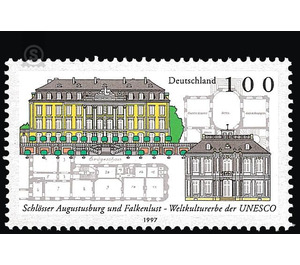Cultural and natural heritage of humanity - Germany / Federal Republic of Germany 1997 - 100 Pfennig
Theme: Architecture
| Country | Germany / Federal Republic of Germany |
| Issue Date | 1997 |
| Face Value | 100.00 |
| Color | grey white |
| Perforation | K 14 |
| Printing Type | Multicolor offset printing |
| Stamp Type | Postage stamp |
| Item Type | Stamp |
| Chronological Issue Number | 1786 |
| Chronological Chapter | GER-BRD |
| SID | 295763 |
| In 34 Wishlists | |
The castles Augustusburg and Falkenlust in Brühl with their parks and gardens have been included in the list of World Heritage Sites by UNESCO as the first important creations of the rococo style in Germany. They preserve the entire complex of an Rococo electoral residence in rare completeness and are unique examples of European artistic creation. Her paintings, stucco work, carvings and wrought-iron works are among the artistic and artistic masterpieces of the first half of the 18th century and have been the model for a large number of other German princely courts. Castle Augustusburg, built from 1725 to 1728, bears the name of its builder Clemens August, Elector and Archbishop of Cologne. It became world famous through its staircase by Balthasar Neumann, probably the most magnificent and beautiful Rococo performance in Germany: a feat, a gorgeous creation that in an enthusiastic movement carries marble, stucco, columns and caryatids and culminates in the stunning ceiling fresco by Carlo Carlone , Schloss Falkenlust, built as a hunting lodge for Clemens August, represents in its purest and most concise form a building type developed in France. The castle is still preserved in its artistic substance as it was conceived and executed in the 18th century. In the castles and gardens of Brühl, the development of Rococo can be experienced in Germany like in no other castle of this kind; they are an outstanding example of 18th century castle architecture. (Text: Administration Castle Brühl)


